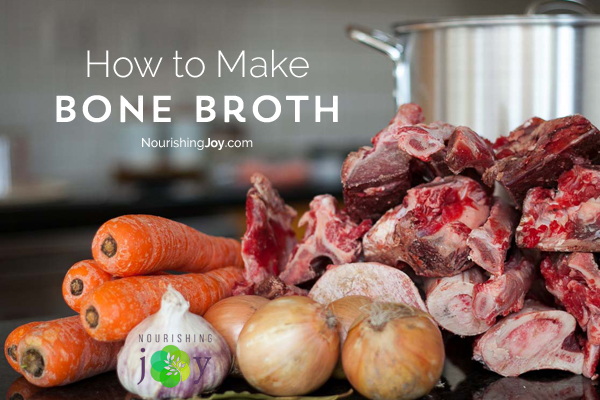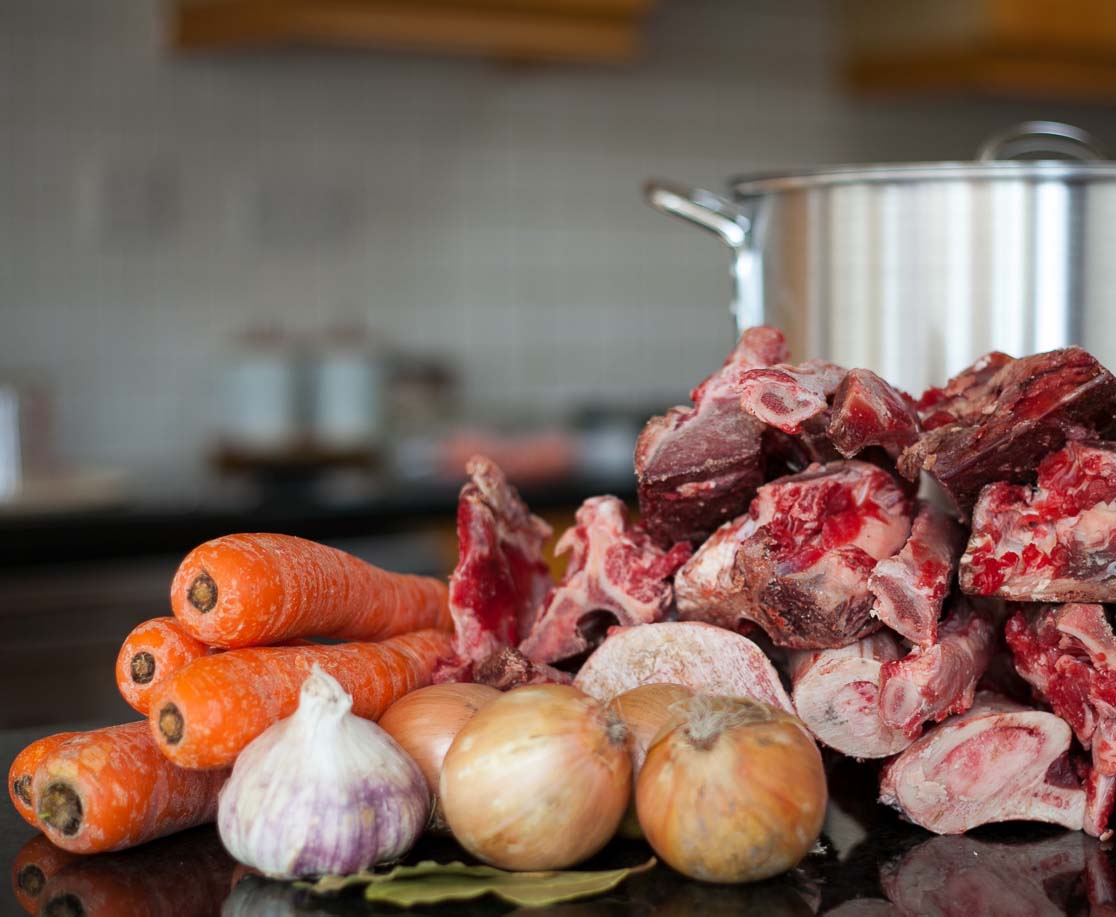How to Make Bone Broth
This post may contain affiliate links, including those from Amazon.com, which means we earn a small commission off your purchases. And here's the thing: We only mention services and products that we think are truly worth your attention, whether they're free, paid, or otherwise. This site relies on YOUR trust, so if we don't stand behind a product 110%, it's not mentioned. Period.



You all know how much I love gelatin and how I swoon over the wide array of benefits it provides to our bodies.
(If you don't, you can read my love letter to gelatin, then read my simple list of 35+ ways to eat more gelatin.)
One of the best and most nutritious ways to eat plenty of gelatin is by consuming bone broth. And since there's lots of buzz around these days about bone broth, I wanted to both show you how to make it and clear up some of the myths that are running around.
So, let's start with some of the basics…
What IS bone broth, anyway?
You may have noticed that I titled this article, “How to Make Bone Broth,” yet in my book, The DIY Pantry, I refer to all the recipes I'm about to show you how to make as “stock,” not “broth.”
You may also have noticed that in amidst all the buzz about the benefits of bone broth and how to make it, both the term “stock” and “bone broth” are tossed around.
So what gives???
The Difference Between Stock and Bone Broth
The difference is actually quite simple, though subtle.
“Stock” is an ingredient. The French appropriately refer to it as a “fond,” or foundation, of other dishes. So when you place a chicken carcass or leftover beef scraps from your Friday night rib roast into a stockpot and cover with water and some vegetables, what you are making is stock. According to my old copy of The Professional Chef, a stock is simply “a flavorful liquid prepared by simmering meaty bones in water with aromatics [usually onions, carrots, and celery] until their flavor, aroma, color, body, and nutritive value are extracted.”
So then once you have that stock – beautifully strained and ready for use – and you then flavor it, you have created a broth. If you're served a delicious soup in a restaurant, for example, you would complement the chef on the tasty broth rather than the tasty stock in your bowl. And this is where flavors really shine! For example, the Chinese and the French make stock fairly similarly, but the broths that each create from that stock – oh! they're each flavored SO differently and so absolutely sublimely.
And further, and perhaps most importantly for our purposes, “bone broth” is not a culinary term, but an explanatory one. “Bone broth” is simply a term to draw our attention to the fact that the broth has been created from stock made exclusively from cartilage-heavy bones – such as those at the joints: knuckle, neck, back, patella, femur, and the feet – and has been prepared in such a way as to extract high amounts of marrow, collagen, minerals, and amino acids.
And for those of us who care about getting as much gelatin and complimentary amino acids as possible, that's important.
So, to sum up:
- Stock = base ingredient
- Broth = flavored stock
- Bone broth = gelatin-and-mineral-rich broth
Now, if you want to get really geeky (which, of course, we all want to do because this is all so fascinating – heh), you might want to know that there are different types of stock, although none of the preparation methods have anything to do with the difference between stock and broth – any stock can be made into broth. The different kinds of stock are generally categorized as white stock, brown stock, and fumets.
- A white stock refers to a bone stock where the bones are placed in the stockpot without roasting them first – such as if you cut up a raw chicken and then were to cook the bones without doing anything else to them first. You want this kind of stock of you're going to be making something light and mild in flavor, like using the stock as a water substitute in a pilaf.
- A brown stock refers to a bone stock where the bones are first roasted or “browned” until they become a deep mahogany color. These bones bring a much deeper, richer flavor to the stock and make the gelatin content more available, so this is the preferred method of making bone stock that will be used in soups, stews, sauces, or for sipping, especially if you're on any type of healing protocol. (This is kind I'm showing you how to make below.)
- A fumet is created by a process somewhat in between the white and brown stocks and is made by sort of sautéing the bones to brown them lightly, then sweating the bones (typically with white wine), and finally simmering them. This technique is typically used when making a fish stock, and you can see a similar technique in action in my How to Make Shrimp Stock tutorial (albeit without the wine).
An Important Note:
Now, there is something important you should know for the times you choose to purchase stocks and bone broth rather than make them yourself:
How you make bone broth matters. And hence, how a company makes their bone broth matters.
If a company or chef boils their bones vigorously in order to quickly mass produce their stock, the nutritional value plummets, as does some of the flavor. So if you open a jar or box of stock and it pours out silky smooth, it may taste lovely, but it's not going to provide you with much of the benefits of gelatin or the related amino acids your body needs. (That doesn't mean it's a bad stock – it just means that if you're looking for the benefits of bone broth, that stock or broth won't provide it.)
What you WANT to see when you open the bag or container of bone stock or bone broth is a well-gelled mass that schlops out into your saucepan or stockpot and which then melts into a lovely, smooth base for your sauces, soups, and stews.
Also, for me, I prefer to source bones from animals I know were on pasture and that never received antibiotics, hormones, or chemicals that may have left residue in the bones that will be extracted into the stock.
Bone Broth Benefits
And of course – the question “WHAT is bone broth?” is logically followed by “WHY eat bone broth?”
As I mentioned in passing above, bone broth is an essential part of a real food diet – especially if you're on any type of healing protocol or dealing with chronic illness.
Here are just a few of my favorite benefits bone broth imparts:
- Bone broth provides the body with copious amounts of needed minerals, most particularly magnesium, sulfur, and a number of trace minerals. Our bodies require these minerals for cellular communication and for nearly every bodily process to function well. But best of all, not only are those minerals PRESENT in bone broth, but bone broth puts those minerals in a form that is easily assimilated in our bodies.
- The gelatin colloids in bone broth help heal and seal the colon so that nutrients may be absorbed. Considering that more than 90% of the nutrients we receive from our food are absorbed in the gastrointestinal tract, this is important!
- The amino acids in bone broth balance out your meat intake. This is one aspect of bone broth I find MOST fascinating! Muscle meats, which comprise the vast majority of our meat intake, contain elevated levels of the amino acids cysteine and tryptophan, which can be inflammatory over time (which is why red meat sometimes gets a bad rap). The gelatin in bone broth, however, contains no cysteine or tryptophan BUT elevated levels of glycine and proline, two anti-inflammatory amino acids, which balance, complete, and complement the other meat sources.
- The gelatin in bone broth can increase cognitive performance, assisting in memory recall and the ability to learn and remember new information.
- The gelatin in bone broth supports healthy digestion and strengthens hair, skin, and nails. It also nourishes connective tissues, which helps to prevent premature skin sagging and cellulite. Bone broth also contains the amino acid proline, which is necessary for the production of collagen.
- The amino acid glycine, which is present in bone broth in significant amounts, is essential for the production of the amino acid glutathione, which helps prevent premature aging and helps erase wrinkles.
So, now that we've got all the grammar out of the way, let's get on to cooking! Stock is super-simple to make, whether you choose to make it on the stovetop, the slow cooker, or the Instant Pot.
How to Make Bone Broth on the Stovetop
Updated just slightly from my book, The DIY Pantry
2-5 pounds bones (enough to fill your stockpot about half to two-thirds full) OR 1 chicken carcass
1-2 chicken feet, cleaned and trimmed (for chicken stock)
Enough water to completely cover the bones by at least 1″, usually about 6 quarts
1 tablespoon vinegar
1 carrot, cut into 2–3″ pieces
3 stalks of celery, cut into 2–3″ pieces
1 onion, peeled and quartered
2–3 bay leaves
1 tablespoon black peppercorns
1 sprig fresh rosemary
1 large handful fresh parsley
If your bones didn't come from a dish that's already been cooked (a rib roast, a roasted chicken, etc), drizzle them with olive oil, then roast them on a sheet pan or a roasting pan at 400°F until deeply colored, 40-60 minutes, turning once.
Place bones or carcass in a large stockpot. Cover with water and add in the vinegar. Let sit for 30-60 minutes. Add chopped vegetables, bay leaves, and peppercorns; bring the water to a boil over high heat. Once boiling, reduce heat to low and let simmer uncovered.
Check the stock every half-hour for the first hour or two to skim off any foam and double-check that the stock is simmering. It should be a very gentle simmer, but you should at least see gently bubbles breaking the surface. If the heat is too low, stock will be hot but not show any movement.
Cover and continue to simmer for 12–18 hours (for poultry) or 24-48 hours (for red meats), adding water as needed to keep the bones submerged.
When you are ready to finish the stock, toss in the parsley and let simmer for a final 10–15 minutes. Filter through a fine-mesh sieve and pour into storage containers. Store stock in the freezer for up to 3 months, in a deep freeze for up to 1 year, or in the refrigerator for up to 5 days.
To make 1 quart of aromatic sipping broth, first sweat 1 cup of chopped vegetables in a small amount of butter over medium heat (think: onions, celery, bell pepper, tomatoes, and definitely at least one clove of garlic – choose any vegetables you wish, although I recommend staying away from brassicas such as cabbage, as they can turn bitter).
When the vegetables are softened, 5-7 minutes, pour in 1 quart of stock. Add a bouquet garni of fresh parsley, thyme, and rosemary (bouquet garni is just a fancy way of saying the fresh herbs are all tied together in a bundle before being dropped into the pot). Reduce heat to medium-low and cover, then gently simmer to infuse the flavors 20-30 minutes. Taste, then add salt and pepper, adjusting to taste.
Serve directly as a soup OR strain out the herbs and vegetables and pour into mugs to sip. Personally, I like to add a bit of salt and chopped fresh parsley to the broth as I sip.
How to Make Bone Broth in the Instant Pot
Depending on the size and type of your bones, you may certainly use more bones beyond the two pounds called for here if they will fit in your pot. You want the bones to fill the insert about half full.
2 lb bones or 1 chicken carcass
1-2 chicken feet, cleaned and trimmed (for chicken stock)
1 large carrot, cut into 2-3″ pieces
1 large onion, peeled and quartered
3 stalks of celery, cut into 2-3″ pieces
1 tablespoon black peppercorns
1 sprig fresh rosemary
1 tablespoon apple cider vinegar
Water to cover
If your bones didn't come from a dish that's already been cooked (a rib roast, a roasted chicken, etc), drizzle them with olive oil, then roast them on a sheet pan or a roasting pan at 400°F until deeply colored, 40-60 minutes, turning once.
Place the bones into the Instant Pot insert, then add the vegetables, peppercorns, and apple cider vinegar. Fill to one inch below the max line with fresh cold water.
If you have time, let the pot sit for about 30 minutes without any heat to let the vinegar begin to leach the minerals from the bones. (If you don't want to have to remember to come back to start it, you can press “Timer” and set to 30 to delay the start for 30 minutes.)
Set on the lid and ensure it is locked in place, then turn the vent valve to closed. Push “Soup,” then change the pressure to “Low” if your model allows it, and use the Manual button to change the time to 120 minutes. (Newer models may allow you more time, so if so, set it to 180.)
The pot will turn “On” automatically and will likely take 20-30 minutes to come to pressure before the 120 minutes starts counting down.
After the cooking time is done, allow the Instant Pot to depressurize naturally, usually 20-30 minutes.
Strain the stock through a fine-mesh sieve and discard the bones and vegetables. Pour into jars or freezer containers and store stock in the freezer for up to 3 months, in a deep freeze for up to 1 year, or in the refrigerator for up to 5 days.
To make into an aromatic sipping broth, see directions above.
How to Make Bone Broth in a Slow Cooker
For the directions in a slow cooker, a beautiful photo tutorial has been provided by Kettle & Fire, a company that makes 100% organic, grass-fed bone broth. They encourage customers to make their own bone broth when they can, and this graphic beautifully illustrates essentially what I have described in the previous two tutorials, but changed specifically for the slow cooker.
A Special Offer: 20% off Organic, Grass-Fed Bone Broth
Now, for the times you don't want to make your own or simply can't, where do you purchase bone broth that you feel good about eating?
One company, Kettle & Fire, has become the gold standard among bone broth producers. There are others, but Kettle & Fire has consistently demonstrated that they're committed to creating the best bone broth you can find.
In fact, on their website they make the audacious claim:
“We started Kettle & Fire with one thing in mind: create the healthiest and best bone broth on the market. From the very beginning, this mission has fueled our search to find the best co-packer, the best bones, the best ingredients, and the best packaging. We're proud to say that we've accomplished our mission, and today we serve up some of the best bone broth you've ever had.”
And they DO live up to their promise! Their bone broth is flavorful, well-gelled, comes from 100% grass-fed/free-range animals, uses 100% organic produce, and they have developed a packaging that doesn't even allow air in the room while the hot broth is being poured into the containers in order to keep them shelf-stable for a couple of years! Now if only I had THAT at canning time….
If you want superb, delicious, gelatinous, ethically-produced bone broth, you'll definitely want to try (and stock-up on) Kettle & Fire.
And because I'm such a fan of Kettle & Fire, they are offering a discount just for Nourishing Joy readers! Get 20% off your first order – this week only. If you haven't tried Kettle & Fire before or have hesitated because of budget constraints, this discount definitely makes it the right time to try it. Just check it out here.







Nourishing joy… Sounds fantastic! But dont you think your principles cross? In section About you write about right choises ‘to make healthier, greener lifestyle choices’, eco-friendly, nontoxic choises. And you sugest Bone Broth! Didnt you hear about Real ecology, Real eco choises, Real decisions for your health and environment? Write about traveling, sport, lifestyle, whatever, but be responsible for other people speaking about health and eco if you wite publicly with such good intentions! Firstly honestly recomend watch Cowspiracy, Forks over knives! Just to meet reality!
I wish you good luck! And be in peace with others (not only humans).
Which is EXACTLY why I write about ethical, sustainable sources of meat too. 🙂 You hit the nail on the head. One can live at peace with ALL of creation – animals, plants, and other humans – and do so compassionately, respectfully, and ethically while still honoring our bodies’ nutritional needs for what is supplied to us in meat and all other foods we eat. We are NOT a vegan website and purposely so. We seek a bigger picture.